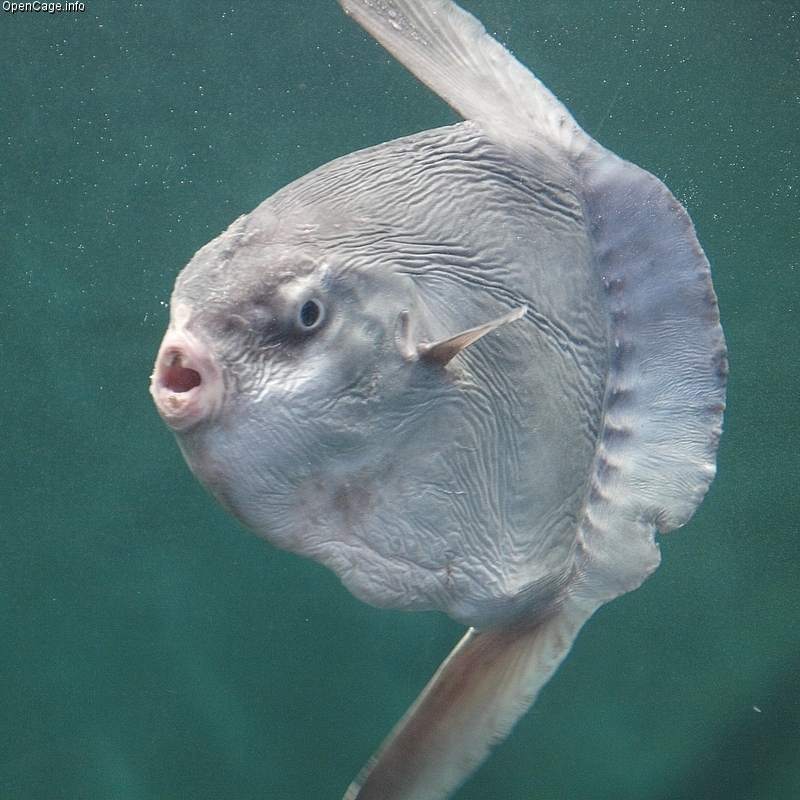The Creature Feature: 10 Fun Facts About the Ocean Sunfish
In honor of a certain "sea monstah" video that went viral recently, this week's creature is the ocean sunfish. The ocean sunfish or common mola (Mola mola) is a huge fish with a bizarre appearance. They look like giant swimming heads. They can be as tall as they are long when their dorsal and ventral fins are extended.Ocean sunfish are native to tropical and temperate waters around the globe. Mola is Latin for "millstone," a reference to the fish's gray color, rough texture, and circular shape. Read on to learn more about these strange ocean giants.
1. Ocean Sunfish are huge. They're the heaviest bony fish in the world, weighing on average over 2,000 pounds. They can grow over 10 feet long and more than 8 feet from fin to fin.
2. They have unusual skeletons. The ocean sunfish's spinal column contains fewer vertebrae and is shorter in relation to its body than that of other fish. It has a reduced skeleton that is mostly cartilaginous, and also lacks ribs.
3. They don't have tails. In most fish the tail is the main means of propulsion, but the ocean sunfish lacks a tail. They also don't have caudal fins. Instead, they have a structure called a clavus, formed by extensions of the dorsal and anal fin rays and used like a rudder. They "paddle" with their dorsal and anal fins, waggling them in the same direction at the same time to move forward.
4. Ocean sunfish have beaks. Their teeth are fused into a beak-like structure, and they have pharyngeal teeth located in their throats.
5. They have thick skins. Ocean sunfish don't have scales. Instead, they have a thick, rubbery skin that is covered in mucus. Their skin can be up to 3 inches thick in some areas.
6. They're great hosts. Ocean sunfish are known to harbor over 40 species of parasites. To remove parasites from their skin, the fish visit drifting kelp fields where cleaner wrasses and other small fish pick at them. By basking on their sides at the surface, ocean sunfish allow seabirds to feed on their skin parasites. It's also thought that breaching, in which they can clear the surface by more than three body lengths, is another effort to dislodge parasites.
7. Ocean sunfish eat mainly jellyfish. Ocean sunfish consume jellyfish, salps, squids, crustaceans, small fish, fish larvae, and eel grass. This diet is nutritionally poor, so they have to eat large amounts to maintain their great size.
8. They are named for their basking behavior. Surface basking behavior, in which a sunfish swims on its side, presenting its largest surface to the sun, may be a way for the fish to thermally recharge after dives into deeper, colder water. They forage for siphonophores, relatives of jellyfish, at depths of between 50 and 200 meters, and have been reported to dive to depths greater than 500 meters. After such dives, they surface to sunbathe and regulate their body temperature.
9. They're prolific egg-layers. Females can produce as many as 300 million eggs at a time, more than any other known vertebrate.
10. Ocean sunfish go through the most extreme size growth of any vertebrate. Newly hatched sunfish larvae are only 2.5 mm long and weigh a fraction of a gram. By adulthood, they could grow more than 60 million times their birth size. Unlike most fish, sunfish pass through two distinct larval phases. During the first phase they resemble tiny pufferfish, with round bodies, spines, and well-developed tails and caudal fins. During the second larval phase, they lose the spines and re-absorb their tails.
References and Other Resources:
Griffin, B. 2011. Mola mola, Animal Diversity Web. Accessed September 24, 2015 at http://animaldiversity.org/accounts/Mola_mola/.Mola mola, Arkive. Accessed September 24, 2015 at http://www.arkive.org/sunfish/mola-mola/.
Nakamura, I., Goto, Y. & K. Sato. (2015). Ocean sunfish rewarm at the surface after deep excursions to forage for siphonophores. Journal of Animal Ecology. 84(3): 590-603. doi: 10.1111/1365-2656.12346.
Nakatsubo, T., Kawachi, M., Mano, N., & Hirose, H. (2007). Estimation of maturation in wild and captive ocean sunfish Mola mola. Aquaculture Science, 55. doi: 10.11233/aquaculturesci1953.55.259.The Ocean Sunfish. Accessed September 24, 2015 at http://oceansunfish.org/Pope, E. C., et al. (2010).
The biology and ecology of the ocean sunfish Mola mola: a review of current knowledge and future research perspectives. Reviews in Fish Biology and Fisheries. 20(4): 471-487. doi: 10.1007/s11160-009-9155-9.Potter, I. F. and Howell, W. H. (2010).
Vertical movement and behavior of the ocean sunfish, Mola mola, in the northwest Atlantic. Journal of Experimental Marine Biology and Ecology. 396(2): 138-146. doi: 10.1016/j.jembe.2010.10.014Watanabe, Y., & Sato, K. (2008).
Functional dorsoventral symmetry in relation to lift-based swimming in the ocean sunfish Mola mola. PLoS One, 3(10), e3446. doi: 10.1371/journal.pone.0003446.




